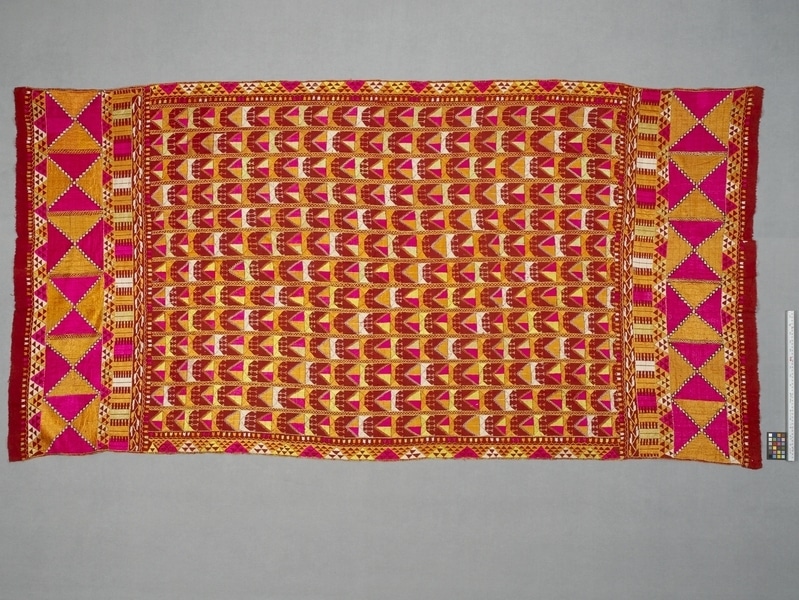Shawl Item Number: Ef191 from the MOA: University of British Columbia


Description
Handspun and handwoven cotton plain weave (khaddar) in three rectangular panels of red-brown cloth sewn together. Geometric style pattern in red, green, white, and gold-coloured stitch embroidered on top. Black used as embroidered outline on ends. Three gold diagonal stripes span the central area, with the colour pattern mirroring the central span. The colouring alternates magenta-green and magenta-gold pyramids (mandiraan) with the pattern flipping by row. The roof of the windows alternate gold-green gold-white patterning.
History Of Use
Phulkari style embroidery is a rural tradition of handmade embroidery, literally meaning "flower work". The main characteristics are the use of a darn stitch on the wrong side of cotton cloth using coloured silken thread. It is a regional embroidery style practiced throughout the Punjab, both in India and in Pakistan, as well as in neighbouring regions.Phulkari style shawls or head covers were often given as gifts on auspicious occasions such as marriages.
Iconographic Meaning
Referred to as a darshan dwaar, door of vision or worship motif, or mandiraan, Hindu temples, da bagh. Each box consists of a mandir (temple) being viewed through a window. The border boxes offer overhead views of the mandir. The innermost border displays a double door-shaped pattern.
Item History
- Made in Punjab, India
- Collected during 1976
- Owned by Stephen Inglis before December 2, 1977
- Received from Museum of Anthropology Donations Fund (Funding source) and Stephen Inglis (Seller) on December 2, 1977
What
- Name
- Shawl
- Identification Number
- Ef191
- Type of Item
- shawl
- Material
- cotton fibre and silk fibre
- Manufacturing Technique
- woven and embroidered
- Overall
- height 118.0 cm, width 235.0 cm
Who
- Culture
- Punjabi
- Previous Owner
- Stephen Inglis
- Received from
- Museum of Anthropology Donations Fund (Funding source) and Stephen Inglis (Seller)
Where
- Holding Institution
- MOA: University of British Columbia
- Made in
- Punjab, India
When
- Collection Date
- during 1976
- Ownership Date
- before December 2, 1977
- Acquisition Date
- on December 2, 1977
Other
- Item Classes
- textiles
- Condition
- good
- Accession Number
- 0411/0149